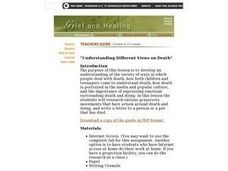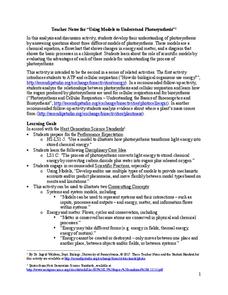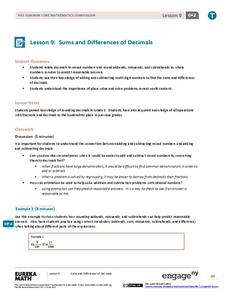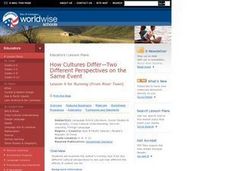Curated OER
Understanding Different Views on Death
A thought-provoking lesson presents how different cultures view death. Upper elementary through high school pupils engage in a series of activities that will leave them with a new understanding of how death is dealt with globally....
Curated OER
Lesson 5- Symme "trees": Understanding Same
Pairs of socks can be the same and they can be different. Use socks to emphasise the meanings of the words same and different. Your special ed class will examine each pair of socks you provide to determine if they are the same or...
Serendip
Using Models to Understand Photosynthesis
Is your class in the dark about photosynthesis? Shed some sunlight on an important biological process with a thoughtful activity. After answering questions to help determine their level of knowledge, learners work with chemical equations...
Carnegie Mellon University
Understanding Electricity Mix Tradeoffs
Use the accompanying presentation and colorful technology sheets to introduce your class to the 10 different energy technologies. Connect kids to an interactive computer tool that allows them to combine different types of power...
Roy Rosenzweig Center for History and New Media
Continental Differences
Students break into groups and closely investigate primary sources associated with the seven different continents. After deciding which continent their primary sources relate to, representatives from each group present their findings to...
Teaching Tolerance
Using Photographs to Teach Social Justice | Affirming Our Commonalities and Differences
Photos can challenge stereotypes. To gain an understanding of the big picture, groups examine a series of photographs and analyze how a photographer's choices can shape a viewer's reaction to an image. For the first set of photographs,...
Curated OER
How We Are Alike And Different
Students engage in a lesson that is concerned with the similarities and differences as part of knowing other children. They use examples of different drinks to illustrate the differences or similarities that are present in the student...
EngageNY
Sums and Differences of Decimals
Sometimes dealing with decimals is so much easier than dealing with fractions. The ninth lesson in a 21-part module has the class consider situations when it might be easier to add or subtract fractions by first converting to decimals....
EngageNY
Successive Differences in Polynomials
Don't give your classes the third degree when working with polynomials! Teach them to recognize the successive differences and identify the degree of the polynomial. The lesson leads learners through a process to develop an understanding...
Curated OER
Understanding the Sociocultural Perspective
Enhance your understanding of basic principles and best teaching practices as they are viewed through a sociocultural lens.
National Nanotechnology Infrastructure Network
Understanding Wave Motion - Slinky vs. Snaky: Which Spring is Dominant?
Ride the wave to an understanding of refraction! The first in a series of two inquiry-based lessons challenges learners to create transverse waves with two different types of springs. As their wave hits an object, they observe the change...
Teach Engineering
Using Hooke's Law to Understand Materials
Provide a Hooke for a lesson on elasticity with an activity that has groups investigate a set of springs. They use a set procedure to collect data to calculate the spring constant for each spring using Hooke's Law. The groups predict the...
NYSU
Understand a Fraction as a Number on a Number Line
Piece by piece young scholars build a basic understanding of fractions in a Common Core-designed elementary math lesson plan. Through a series of hands-on activities and journaling exercises, and with the help of multiple...
Curated OER
Lesson: Differing World Views: Human and Animals
Kids challenge their understanding of the world around them and consider the impact man has on the environment and animal life. They examine a Tlingit piece, read two Tlingit stories about man and animals, then participate in a research...
PBS
Who, Me? Biased?: Understanding Implicit Bias
A 10-page interactive explains different facets of implicit bias, demonstrates how implicit bias works, and how people can counteract its effects. The interactive tools permit users to save their information in "My Work" folders, to take...
Illustrative Mathematics
Making 22 Seventeenths in Different Ways
There is more than one way to determine a sum. Scholars demonstrate their understanding of the decomposition of fractions similar to the decomposition of whole numbers. The short task requires pupils to determine which sums of fractions...
Curated OER
Everyone Has a Culture -- Everyone is Different
Students are shown various statements and respond to each as a class. They discuss the differences between different groups of people and why they behave differently as well. After completing a worksheet, they discover aspects of their...
Curated OER
How Are We Different?
Students discuss the differences between boys and girls. In this acceptance instructional activity, students view pictures of boys and girls and use a Venn Diagram to chart their differences. Students discuss boy activities and girl...
Curated OER
How are Seeds Alike and Different?
Second graders examine the seeds in fresh fruit. In this seeds lesson, 2nd graders view different seeds and tell how they are alike and different. Students separate the seeds into groups according to their characteristics.
Curated OER
Understanding Points of View
Investigate the importance of author's point of view. Young linguists study primary source documents related to the Treaty of Casco Bay. The first source is authored by the Native American Chiefs, the second by an English...
Curated OER
How Cultures Differ "Two Different Perspectives on the Same Event
Students read excerpts from Peter Hessler's River Town: Two Years on the Yangtze and discuss his difficulties in learning the language, cultural clashes and how cultural perceptions shape our understanding of the world.
Visa
Financial Forces: Understanding Taxes and Inflation
Take the opportunity to offer your young adults some important financial wisdom on the way taxes and inflation will affect their lives in the future. Through discussion and review of different real-world scenarios provided in this...
Curated OER
Math in English Skills III Exercise Book: Understanding Fractions
Fractions can be tricky, and there is no better way to tackle tricky topics than with a visual representation. Intended for learners in grades two and three, this set of printable worksheets provides a variety of fractions represented in...
Visa
Nothing But Net: Understanding Your Take Home Pay
Introduce your young adults to the important understanding that the money they receive from their paychecks is a net amount as a result of deductions from taxes. Other topics covered include federal, state, Medicare and social security...

























